- News
- Reviews
- Bikes
- Accessories
- Accessories - misc
- Computer mounts
- Bags
- Bar ends
- Bike bags & cases
- Bottle cages
- Bottles
- Cameras
- Car racks
- Child seats
- Computers
- Glasses
- GPS units
- Helmets
- Lights - front
- Lights - rear
- Lights - sets
- Locks
- Mirrors
- Mudguards
- Racks
- Pumps & CO2 inflators
- Puncture kits
- Reflectives
- Smart watches
- Stands and racks
- Trailers
- Clothing
- Components
- Bar tape & grips
- Bottom brackets
- Brake & gear cables
- Brake & STI levers
- Brake pads & spares
- Brakes
- Cassettes & freewheels
- Chains
- Chainsets & chainrings
- Derailleurs - front
- Derailleurs - rear
- Forks
- Gear levers & shifters
- Groupsets
- Handlebars & extensions
- Headsets
- Hubs
- Inner tubes
- Pedals
- Quick releases & skewers
- Saddles
- Seatposts
- Stems
- Wheels
- Tyres
- Health, fitness and nutrition
- Tools and workshop
- Miscellaneous
- Cross country mountain bikes
- Tubeless valves
- Buyers Guides
- Features
- Forum
- Recommends
- Podcast
review
£2,999.99
VERDICT:
Well thought out, well designed bike with a great frame & transmission - slightly flexy wheels are the only drawback, but it is also available as a frameset
Weight:
7,890g
Contact:
www.kovertracing.com
At road.cc every product is thoroughly tested for as long as it takes to get a proper insight into how well it works. Our reviewers are experienced cyclists that we trust to be objective. While we strive to ensure that opinions expressed are backed up by facts, reviews are by their nature an informed opinion, not a definitive verdict. We don't intentionally try to break anything (except locks) but we do try to look for weak points in any design. The overall score is not just an average of the other scores: it reflects both a product's function and value – with value determined by how a product compares with items of similar spec, quality, and price.
What the road.cc scores meanGood scores are more common than bad, because fortunately good products are more common than bad.
- Exceptional
- Excellent
- Very Good
- Good
- Quite good
- Average
- Not so good
- Poor
- Bad
- Appalling
Kovert's top of the range FX-Pro is pitched at what is probably the most hotly contested bike battle of 2012 – the one to be the best affordable electronic shifting bike. Launched at the 2011 Cycle Show, Kovert's ethos is to bring race bikes to the market at affordable prices. The brand's racing commitment is underlined by the Kovert Elite Racing Team who are already bringing in the early season results using the FX-Pro frameset. Affordability, well it's not the cheapest out there but, full carbon frameset, carbon/alloy wheels and Ultegra Di2 for a penny under £3k – I'll let you decide.
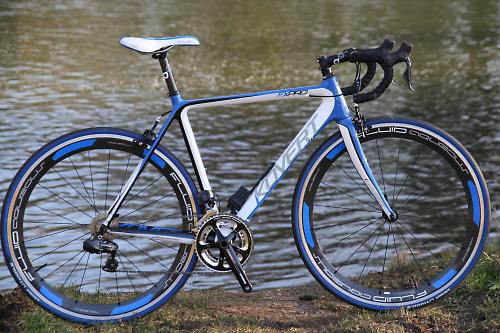
Firstly let's take a look at the 12k unidirectional carbon frame. As you'd expect the FX-Pro is designed for racing with our 54cm model having steep head and seat angles of 72.5° and 74° respectively. An oversized triangular downtube (with the flat side pointing at the ground) keeps things tight, also thanks to the tapered headtube and the oversize bottom bracket area. Put the hammer down and you aren't going to feel any waste of power. The back end follows much the same mantra, curved chunky seat and chainstays harness everything you put through the pedals.
The fork is also UD carbon for the legs and steerer. The top of the fork legs are allowed a large cross sectional area thanks to the smooth blend into the oversize headtube which should see the steering stay tight under load.
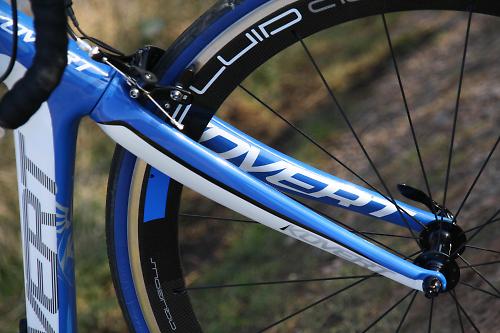
The FX-Pro frame is designed for electronic shifting only so internal routing for the Ultegra Di2 wires keeps it looking clean as they disappear into the headtube, reappearing next to the mechs. There is also internal routing for the rear brake cable travelling through the toptube, thankfully without any irritating noise from road buzz or vibration.
The finishing kit is mostly Kovert's in house Fluid brand which covers the handlebars, stem, seatpost, saddle, brakeset and wheels. The handlebars are 31.8mm diameter alloy as is the matching stem, they both look pretty standard affairs, in a getting the job done kind of way. The 31.6mm diameter seatpost is full carbon with zero layback, a simple two bolt clamp design attaching the cromoly (production models get titanium) saddle rails to the alloy cradle.
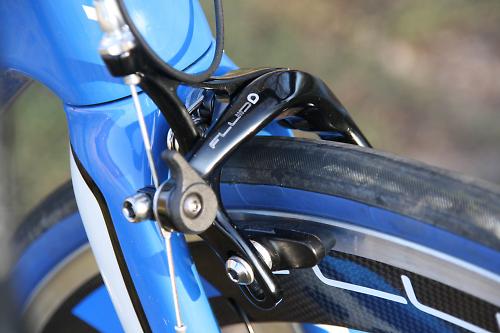
The Mercurial dual pivot callipers come with Swiss Stop pads which always give confident stopping power in the wet and dry. The black finish ties in well with the frame colour as well.
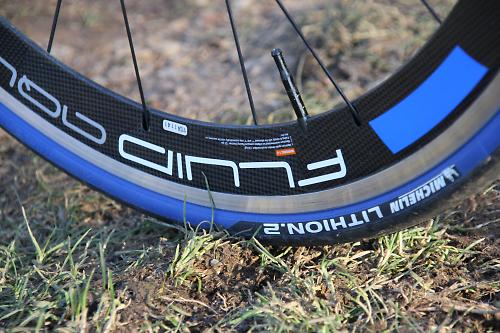
The show stoppers though are the carbon/aluminium deep section wheels. These Fluid Aqueous wheels are 50mm deep, a mixture of alloy braking surface and carbon aero fairing should see them shift on the flat when in that all important lone break. The Fluid hubs are mated to DT Swiss aero-bladed spokes, 20 at the front and 24 at the rear. The lacquered weave and showy logos certainly look the part.
Of couse the big selling point of the FX-Pro though is the Ultegra Di2 shifters and mechs, Dave and Mat have already written a piece on the ins and outs of the technology of it so I won't go into too many details here. A quick look at the key points and then I'll let you what it's like to live with.

In terms of layout the shifters are much the same as the mechanical versions. The hoods are narrower though thanks to removing all the bolts, springs etc and replacing them with whatever makes Di2 shifting works. You'll find the shifter buttons positioned in much the same place as where you'd push the brake lever and paddle and a simple click springs the motors into life to change gear. Once things are set up you shouldn't need to touch the set up again thanks to the self trimming and preset mech positions. If things do go a little awry there is a button on the battery monitoring box which allows tweaking.

Speaking of battery monitoring, the burn time of it is always the biggest concern judging by the fact that it is the first question anyone asks. Well, to put your mind at rest I clocked up over 600 miles with the majority of them below freezing and the monitor was still showing green, >50%. If things do go pear shaped and you run out of electricity shifting at the front mech will stop first allowing you to have the option of shifting at the cassette to get you home. A quick charge for 90 minutes sees you topped up to full capacity again.
If you do happen to crash, the rear mech automatically tucks itself inwards to minimise damage as soon as it detects an impact. Waterproofing is said to have been improved over Dura Ace Di2 and certainly over the test period our FX-Pro saw plenty of rain, mud, salt and general grime without a single murmur of complaint.

Odd as it may seem Kovert's standard spec for the FX-Pro is with an FSA Energy compact (50-34) chainset. A sign of the times possibly highlighting the fact that most top end race bikes these days are bought for sportives and general fitness riding around the lanes. Kovert will tweak the spec at the time of purchase though if you require if you fancy a more traditional 53-39 setup.
With the amount of bikes we've tested lately sporting BB30 it almost seems odd here to see FSA's MegaExo bottom bracket cups screwed into the frame. There has never been any issue with them so no reason to be changed just for the sake of it.
All this is assembled here in the UK by Kovert's mechanics so quality can be monitored before the bikes can reach their new owners.
Out on the road the Kovert has a very subtle ride, it'll happily munch miles and miles with very little problem. For a race machine it's also very well behaved at slower speeds with no twitchiness of the steering or harshness over rough surfaces. Give the pedals a prod though and the FX-Pro really comes alive. The feedback from the frame and fork is very good, a very solid feel yet it manages to absorb the road buzz. Once up to speed the aero wheels cut through the air and are easy to keep rolling, the 145mm headtube allows you to get a good low position in the drops keeping things spinning along.
Acceleration is brisk, quicker than its 7.8kg would suggest thanks to the stiffness of the frame. The oversize downtube and rear triangle do their jobs resisting the forces as the power goes down. There is some flex in the wheels side to side when out of the saddle, enough that I had to back off the brake pads an extra couple of millimetres to avoid rub.
Point the FX-Pro downhill and that race geometry distributes your weight to keep the bike perfectly balanced. The handling is sharp and cornering lines are easily controlled using just a shift in body weight to either side of the stiff handlebars. The braking surface on the Fluid wheels working nicely with the Swiss Stop pads, much more feel than the grabby nature of full carbon rims.
Uphill the flex in the wheels again detract from the great work the frame is doing, the noise of the spokes rubbing on the carbon as they enter the rim drives you insane on long climbs. Other than the wheels though climbing is a joy. The position is spot on in or out of the saddle and that stiffness shines through again. The weight is well balanced so there is no irritating rear wheel spin or lifting of the front wheel on steeper sections. Even the compact chainset isn't required here – the Kovert climbs that well. The 11-25 cassette and 50 ring provides enough gears to get up virtually anything. Indeed the minimal amount of use the front mech got is probably why the battery lasted so well on the Di2.
The Aqueous wheels roll well thanks to the Fluid hubs and stayed true throughout the testing. The flex at the rims though is annoying, the evidence of the spokes rubbing on the carbon was quite marked and the squeaking noise as it did so makes your teeth itch. The front rim must have had a slight high point as you could feel it grabbing under hard braking causing some fork judder. The Michelin Lithion tyres were pretty good, okay for grip but not the fastest rolling. The Aqueous rims have a pressure limit of 125psi, the same as the max pressure of the tyres so that's possibly the deciding factor of them being spec'd.
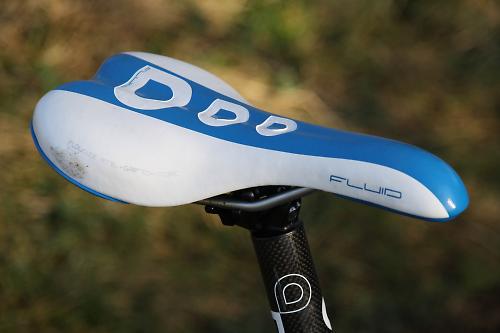
All the rest of the finishing kit works well, the saddle has more padding than I'd normally ride but it was more than comfortable for long hours on the bike. The bars and stem were more than stiff enough whether sprinting or climbing and the seatpost was a good tight fit in the frame so no slippage problems.
The FSA chainset, while completely under geared shifted well and ran smooth on the outboard bearings. The red logo did look at odds with the blue and white colour way of the frameset, to me at least, but that's just nit picking.
The benefits of the Ultegra Di2 shifting are felt everywhere. I personally didn't get the whole electronic revolution thing when Dura Ace Di2 was released, what could motors bring to gear changing that cables could not? Consistency, that is the main advantage. While the shift is not necessarily any better than a perfectly set up mechanical system it remains that way. Without the mechanical foibles of cable stretch, awkward cable routing issues and cable degradation you get perfect shifting every time. This makes it perfectly suited to all weather commuting, maybe not right now as the cost is prohibitive for most people but certainly as the technology trickles down. The shift is quicker and lighter as well, both these add up to less fatigue in your wrists and hands plus the issue of being in the wrong gear is no longer a problem as the shift is still effortless even under huge load and low cadences.
The shift buttons are easily pressed even with thick gloves on and as I mentioned above the narrower hoods are much more comfortable. The levers are reach adjustable so even those with small hands will have no problem reaching the brakes.
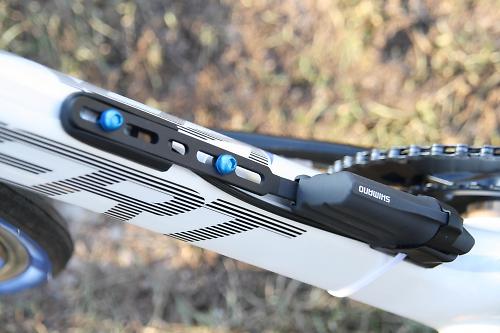
It's not all rosy though. I still think the mechs look ugly and clumpy with the massive motors on them, the front especially. The battery positioning on the FX-Pro looks out of place as well, having to use a cable tie to secure it alongside Shimano's own bottle cage bolt mounted bracket just looks a little tacky, especially after all the hard work that's gone in to the internal cable routing to keep the frame looking clean.
I understand that Di2 takes user serviceability away but thanks to Shimano releasing their latest diagnostics to LBS's if it does go wrong it shouldn't be too difficult to fix.
Overall the Kovert FX-Pro is a great bike slightly let down by the wheels. It's not the cheapest Ui2 bike out there but real thought and quality has gone into the frame and how it's going to ride and I think the price reflects that. The Kovert is a race ready machine that is just at home with the fitness or club rider and will certainly flatter your riding. It looks great and the paintjob is top notch giving a real top end feel to the frameset as do the finishing touches like the anodized bottle cage bolts.
The Ultegra Di2 gears worked brilliantly and I'd happily use electronic full time it's that good. The aesthetics are a small price to pay for constant clean shifting plus a recharge every 1000 miles.
Verdict
A well thought out, designed and built bike with loads of feedback and a comfortable ride. The frame is great plus sensible level components complete the package. The wheel flex was a bit of a fly in the ointment but you do get some payback on the flat sections from the aero benefits. The FX-Pro is also available as a frameset for £1299 if you fancy building it up to your own spec.
road.cc test report
Make and model: Kovert FX-Pro
Size tested: 54
About the bike
State the frame and fork material and method of construction. List the components used to build up the bike.
Uni Directional carbon fibre for the frame and fork allowing the lay up to reflect how the frame reacts to certain inputs.
Colour- Cyan blue, white, black
Frame- 12K carbon monocoque with oversized downtube and Di-2 internal wire routing
Fork- Full UD Carbon fibre
Shifters- Shimano Ultegra Di-2 20 speed
Front mech- Shimano Ultegra Di-2 double
Rear mech- Shimano Ultegra Di-2
Brakes- Fluid mercurial dual pivot alloy calipers with Swiss stop cartridge pads
Chainset- FSA Energy compact 50/34T
Cassette- Shimano CS-5700 10 speed 11/25T
Chain- Shimano 105
Bottom bracket- FSA MegaExo
Rims- Fluid Aqueous 50mm carbon alloy 20H front, 24H rear
Hubs- Fluid Aqueous alloy
Spokes- DT Swiss bladed
Tyres- Michelin Lithion 2 TS, 700 x 23c
Handlebars- Fluid Expert superlight alloy, 131mm drop, 84mm reach
Stem- Fluid superlight alloy 31.8mm bar bore
Headset- FSA oversized
Spacers- Kovert alloy superlight
Seatpost- Fluid full carbon 34.9mm x 300mm
Saddle- Fluid Lithium with FlowGlide panel and Titanium rails
Tell us what the bike is for, and who it's aimed at. What do the manufacturers say about it? How does that compare to your own feelings about the bike?
"Sprint, climb, coast the FX-PRO really does it all and does it well." Kovert say and I tend to agree with them, it rides very well.
Frame and fork
Overall rating for frame and fork
8/10
Tell us about the build quality and finish of the frame and fork?
The finish quality is excellent and the paint work is top class
Tell us about the materials used in the frame and fork?
Uni directional carbon fibre
Tell us about the geometry of the frame and fork?
steep race angles
http://www.kovertracing.com/wp-content/uploads/2011/09/FXPRO-frameset-ge...
How was the bike in terms of height and reach? How did it compare to other bikes of the same stated size?
A 54cm top tube and a 54cm seatube on our size 54cm says it all really. getting a powerful comfy position was never an issue
Riding the bike
Was the bike comfortable to ride? Tell us how you felt about the ride quality.
Yes, the frame absorbs the bumps while remaining stiff. the wheels can rattle over rough stretches of tarmac
Did the bike feel stiff in the right places? Did any part of the bike feel too stiff or too flexible?
Nope, its a good balance
How did the bike transfer power? Did it feel efficient?
Yes very well
Was there any toe-clip overlap with the front wheel? If so, was it a problem?
No
How would you describe the steering? Was it lively, neutral or unresponsive? it reacts to the speed you're travelling at
Tell us some more about the handling. How did the bike feel overall? Did it do particular things well or badly?
Very balanced and stable. the front end loads up nicely in the bends and the steering remains controllable though fast
Which components had the most effect (good or bad) on the bike's comfort? would you recommend any changes?
The saddle is comfortable helped by the absorbent frame
Which components had the most effect (good or bad) on the bike's stiffness? would you recommend any changes?
The bar, stem combo and seatpost were all stiff enough to not waste power
Which components had the most effect (good or bad) on the bike's efficiency? would you recommend any changes?
A solid crankset and bottom bracket area kept things tight
Rate the bike for efficiency of power transfer:
8/10
Rate the bike for acceleration:
7/10
Rate the bike for sprinting:
8/10
Rate the bike for high speed stability:
8/10
Rate the bike for cruising speed stability:
8/10
Rate the bike for low speed stability:
8/10
Rate the bike for flat cornering:
7/10
Rate the bike for cornering on descents:
7/10
Rate the bike for climbing:
7/10
The drivetrain
Rate the drivetrain for performance:
9/10
Rate the drivetrain for durability:
7/10
everything seems good but early days yet
Rate the drivetrain for weight:
7/10
only a smidge heavier than the mechanical Ultegra
Rate the drivetrain for value:
7/10
Tell us some more about the drivetrain. Anything you particularly did or didn't like? Any components which didn't work well together?
Performance is brilliant, the shifter hoods are more comfortable than the mechanical version
Wheels and tyres
Rate the wheels and tyres for performance:
6/10
Good in a straight line but flex in the rims is annoying
Rate the wheels and tyres for durability:
7/10
Rate the wheels and tyres for weight:
7/10
Rate the wheels and tyres for comfort:
7/10
Tell us some more about the wheels and tyres.Did they work well in the conditions you encountered? Would you change the wheels or tyres? If so, what for?
I'd change the wheels for something stiffer even if it meant foregoing the aero advantage
Controls
Rate the controls for performance:
8/10
Rate the controls for durability:
8/10
Rate the controls for weight:
7/10
Rate the controls for comfort:
8/10
Tell us some more about the controls. Any particularly good or bad components? How would the controls work for larger or smaller riders?
The Fluid components are workman-like rather than flash but they are supportive and comfortable
Your summary
Did you enjoy riding the bike? Yes
Would you consider buying the bike? Yes but I'd change the wheels,
Would you recommend the bike to a friend? Yes
Rate the bike overall for performance:
8/10
Rate the bike overall for value:
7/10
About the tester
Age: 34 Height: 180cm Weight: 78kg
I usually ride: Genesis Flyer My best bike is: Ribble Gran Fondo
I've been riding for: 10-20 years I ride: Every day I would class myself as: Expert
I regularly do the following types of riding: time trialling, commuting, club rides, sportives, fixed/singlespeed,
Since writing his first bike review for road.cc back in early 2009 senior product reviewer Stu has tested more than a thousand pieces of kit, and hundreds of bikes.
With an HND in mechanical engineering and previous roles as a CNC programmer/machinist, draughtsman and development engineer (working in new product design) Stu understands what it takes to bring a product to market. A mix of that knowledge combined with his love of road and gravel cycling puts him in the ideal position to put the latest kit through its paces.
He first made the switch to road cycling in 1999, primarily for fitness, but it didn’t take long for his competitive side to take over which led to around ten years as a time triallist and some pretty decent results. These days though riding is more about escapism, keeping the weight off and just enjoying the fact that he gets to ride the latest technology as part of his day job.
Latest Comments
- Bigtwin 6 min 9 sec ago
I for one like your contribution. I mean, it's good to know that Tory ex-Home Secretaries are busy spewing bile into their keyboards at home, not...
- Bigtwin 33 min 23 sec ago
A smidge of £8.5K. Seriously. Someone needs to have a strong coffee.
- Bigtwin 37 min 9 sec ago
Business model innit? When they brought in hire bikes in our town, they approached the bike shop I was then running to so the maintence. It was...
- IanEdward 44 min 22 sec ago
Nice, tyre clearance AND 2x AND non-boring paint jobs, a good alternative to Giant Revolt/ Canyon Grizl....
- Hirsute 50 min 28 sec ago
For the first time, the Norwegian government has calculated the value to society of the health benefits of increased walking and cycling. ...
- graybags 56 min 49 sec ago
I managed to do 12 200k's over 12 months , but unfortunately didn't read the rulles, two were in the same month and I missed a month..................
- nodgedave 1 hour 1 min ago
Toddle off cynic. A great man posting about extremely awful things and you chose to say that? The UCI needs clinical experts like you ... toddle...
- SecretSam 1 hour 12 min ago
Said the spokesperson for Big Hookless































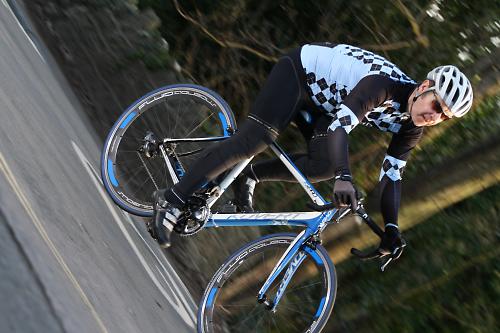





Add new comment
2 comments
I'm glad I read this review before riding this bike today at the Sportivephoto Spring Classic - I got a lend - otherwise I'd have panicked about the horrendous noise coming from the wheels and pushed it back to the start.
Today was the first time I'd ridden a full carbon road bike and had always thought they sounded like a Marshall Amp being switched on - a low hum - as they passed me, usually up climbs. To continue the (tenuous) musical imagery, descending on this was like a Phil Collins drum solo and climbing sounded like a Stockhausen concert.
What do those carbon bits in the wheels do exactly? I'm no lightweight, so I'm guessing my non-aerodynamic profile may contribute to more flex - I'm kinda hoping it was the POWER I was putting through the pedals on the climbs, but as butterflies were passing through the spokes unharmed most of the time, I'm guessing that's just in my head.
Very stiff and responsive bike. Lightweight and also looks very flash.. At £1299.99 for the frameset you really can't go wrong and £2999.99 for complete bike.